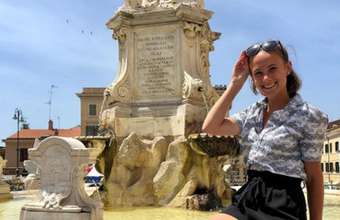
Are you struggling to choose between graduate studies in history, literature, drama or philosophy? Why not explore a degree program that let’s you learn about all these topics and more?
The Department of Classics at Queen’s University allows for a multidisciplinary exploration of the Greco-Roman world. Where else can you study Ancient Humour or Warfare in the Ancient World?
Classical Studies wasn’t the first choice of undergraduate degree for Emily Croft, who is a masters student under the supervision of Dr. Cristiana Zaccagnino. Emily came to Queen’s planning to major in French, but she fell in love with Classical history in first year. “I always loved ancient history, I just didn’t know it was something feasible that I could study. But then when I saw the course catalogue I thought, wow, what an amazing option!”
Now, Emily is completing a Major Research Essay (MRE) exploring the representation of textiles in Roman wall paintings found along the Italic peninsula. Emily’s MRE is perfectly tailored to her interests and experiences. She’s “always been around textiles in some way,” as her mother owned a sewing store.


(photos left - Two examples of ancient Roman painted textiles saved by “unusual preservation methods.” The yellow panels on the left and the hyper-saturated scene on the right were both preserved in Pompeii by the ash from Mount Vesuvius.)
It’s theorized that ancient Romans decorated their houses with grand tapestries and painted frescos. The textiles have not survived, but the wall paintings have. Paintings were “typically done in rooms that would be viewed by the public because the Romans were trying to impress a message of superiority and wealth. Painting these large panels was a way to impart a lot of colour onto the wall, and colour – especially Egyptian blue – was money.”

(GIF above - You may remember the infamous eruption of Mount Vesuvius from Disney’s series, Loki. In real life, the ash cloud served to create anaerobic conditions that kept the pigments in wall paintings from deteriorating.)
MRE projects often involve extensive study of previously published works, but Classics and Classical Studies aren’t just about reading dusty tomes. There are also travel opportunities through Queen’s faculty-directed field work, like the Caere Excavation Project in Italy and the Balkan Heritage Project in the Republic of Macedonia.
While the digs are exciting, these travel opportunities are not like Indiana Jones movies. “It’s a wonderful action movie, but archeologists do not just run in and snatch things. It’s just a really bad precedent to set. There is so much paperwork that has to be done, and you’re not just going in and fighting with the locals.” If you want a better picture of Classical Studies and archeology, you’re getter off watching The Dig. Although even this film underrepresents the permits required.
Closer to home, Queen’s boasts an impressive on-site antiquities collection. The Diniacopoulos Collection includes 627 Greek and Roman coins, many of which have yet to be identified and studied. The Department of Classics and the Art Conservation program at Queen’s allow students to restore, preserve and document these coins as part of their theses.
The hands-on experience acquired by Queen’ students through fieldwork and the Diniacopoulos Collection is extremely important for their career trajectory. Emily’s main advice for classical studies students is to “try to get a job in the field, even if it’s something that might not necessarily fall into your wheelhouse Just getting your foot in the door is important.” Currently, Emily works as a Collections Assistant, compiling a textile exhibit for the Arnprior and District Museum. She is also looking forward to a summer apprenticeship with a textile conservator in Alberta.
Emily received a Graduate Scholarship from the Social Sciences and Humanities Research Council of Canada and won the Medal in Classics during her undergrad. She is looking forward to a textile conservation apprenticeship this summer.
Emily’s experience is that “the biggest thing that makes [Classical Studies students] employable is that we have the ability to write.” This skillset allows Classics and Classical Studies majors to be successful lawyers, archivists, librarians, and even podcast producers. Another major perk is that proficiency in a second language is a core competency of the graduate program, meaning students have the opportunity to learn a second language.
The department of Classics and Classical Studies at Queen’s is one of the university’s founding areas of study. But despite being ancient (literally), Classics is still an evolving field. Emily is “hoping to see the field diversify in terms of who can access the program, and also the content we’re studying." With passionate students like Emily leading the charge, there’s no telling where Classical Studies is headed next.
For more details on the Classics program visit the Classics website.